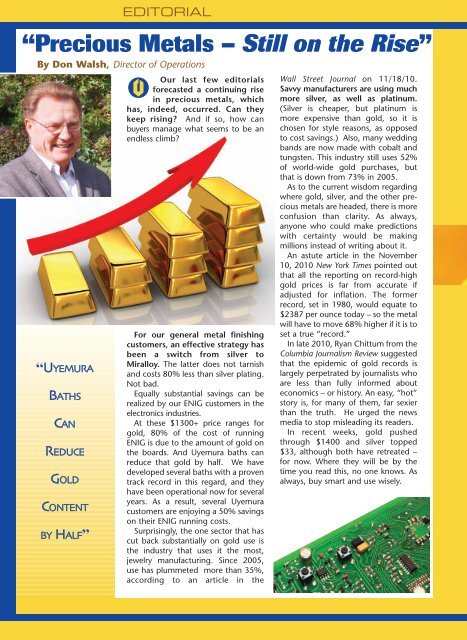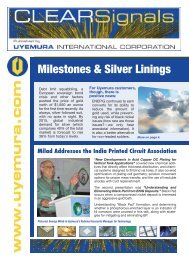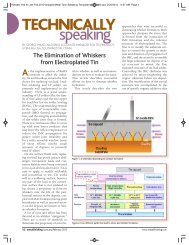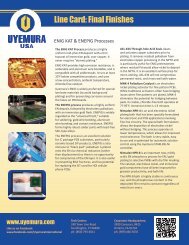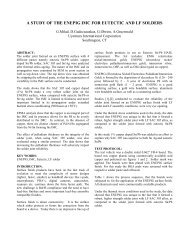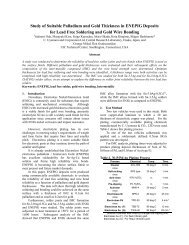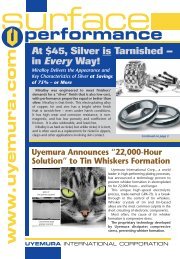Uyemura PCB Newsletter - Uyemura International Corp.
Uyemura PCB Newsletter - Uyemura International Corp.
Uyemura PCB Newsletter - Uyemura International Corp.
Create successful ePaper yourself
Turn your PDF publications into a flip-book with our unique Google optimized e-Paper software.
EDITORIAL<br />
“Precious Metals – Still on the Rise”<br />
By Don Walsh, Director of Operations<br />
“UYEMURA<br />
BATHS<br />
CAN<br />
REDUCE<br />
GOLD<br />
CONTENT<br />
BY HALF”<br />
Our last few editorials<br />
forecasted a continuing rise<br />
in precious metals, which<br />
has, indeed, occurred. Can they<br />
keep rising? And if so, how can<br />
buyers manage what seems to be an<br />
endless climb?<br />
For our general metal finishing<br />
customers, an effective strategy has<br />
been a switch from silver to<br />
Miralloy. The latter does not tarnish<br />
and costs 80% less than silver plating.<br />
Not bad.<br />
Equally substantial savings can be<br />
realized by our ENIG customers in the<br />
electronics industries.<br />
At these $1300+ price ranges for<br />
gold, 80% of the cost of running<br />
ENIG is due to the amount of gold on<br />
the boards. And <strong>Uyemura</strong> baths can<br />
reduce that gold by half. We have<br />
developed several baths with a proven<br />
track record in this regard, and they<br />
have been operational now for several<br />
years. As a result, several <strong>Uyemura</strong><br />
customers are enjoying a 50% savings<br />
on their ENIG running costs.<br />
Surprisingly, the one sector that has<br />
cut back substantially on gold use is<br />
the industry that uses it the most,<br />
jewelry manufacturing. Since 2005,<br />
use has plummeted more than 35%,<br />
according to an article in the<br />
Wall Street Journal on 11/18/10.<br />
Savvy manufacturers are using much<br />
more silver, as well as platinum.<br />
(Silver is cheaper, but platinum is<br />
more expensive than gold, so it is<br />
chosen for style reasons, as opposed<br />
to cost savings.) Also, many wedding<br />
bands are now made with cobalt and<br />
tungsten. This industry still uses 52%<br />
of world-wide gold purchases, but<br />
that is down from 73% in 2005.<br />
As to the current wisdom regarding<br />
where gold, silver, and the other precious<br />
metals are headed, there is more<br />
confusion than clarity. As always,<br />
anyone who could make predictions<br />
with certainty would be making<br />
millions instead of writing about it.<br />
An astute article in the November<br />
10, 2010 New York Times pointed out<br />
that all the reporting on record-high<br />
gold prices is far from accurate if<br />
adjusted for inflation. The former<br />
record, set in 1980, would equate to<br />
$2387 per ounce today – so the metal<br />
will have to move 68% higher if it is to<br />
set a true “record.”<br />
In late 2010, Ryan Chittum from the<br />
Columbia Journalism Review suggested<br />
that the epidemic of gold records is<br />
largely perpetrated by journalists who<br />
are less than fully informed about<br />
economics – or history. An easy, “hot”<br />
story is, for many of them, far sexier<br />
than the truth. He urged the news<br />
media to stop misleading its readers.<br />
In recent weeks, gold pushed<br />
through $1400 and silver topped<br />
$33, although both have retreated –<br />
for now. Where they will be by the<br />
time you read this, no one knows. As<br />
always, buy smart and use wisely.


